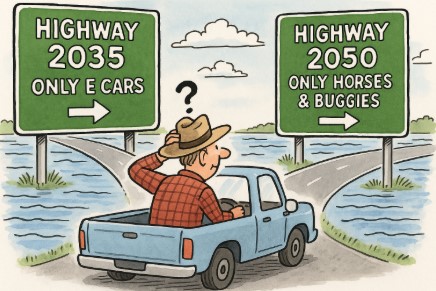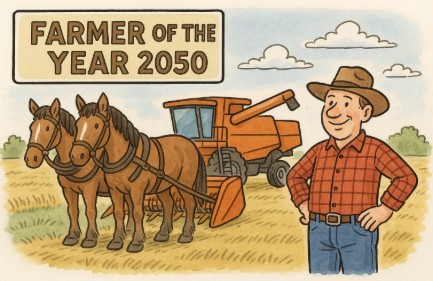
Article by Trevor Whittington, CEO WAFarmers, courtesy of Australian Rural & Regional News
06.10.2025

The ink is barely dry on Canberra’s new 2035 carbon targets, and the climate catastrophists are already eyeing 2050, the holy grail when net zero will finally be achieved.
Out in the Wheatbelt, most farmers shrug. Another distant date, another government promise, most have tuned out with the view that what I can’t see does not hurt me — a bit like the GRDC levy that nicks 1 per cent of farm-gate revenue.
But let’s be clear. Just like your compulsory research levy comes off your bottom line, the costs of the government’s carbon targets will also come off your bottom line. The difference is they will be buried deep in the supply chain of your costs of production, hidden under soothing titles like the Safeguard Mechanism. Notice how the government avoids words like tax or cost. Instead, it brands carbon measures with neutral or positive labels: the Capacity Investment Scheme, Powering the Regions Fund, Rewiring the Nation, the Emissions Reduction Fund, the National Reconstruction Fund, the Climate Solutions Package, the Nature Repair Market, the Climate Adaptation Strategy, the Net Zero Economy. These terms function as euphemisms. They signal policy direction while muting the reality: compliance costs, disguised taxes, or transfer payments. All sold as targeting “the big polluters.” But the fine print says otherwise.
The Safeguard Mechanism is the one to watch as it covers any facility emitting more than 100,000 tonnes of CO2-e a year. That net includes chemicals, fertilisers, fuel, grain handling, meat processing and shipping.
Under the government’s 2030 — and now 2035 — targets, each of the companies involved in the agricultural supply chain has a “baseline cap” set on their emissions of what is either plant food or pollution, depending on your perspective of CO2.
Under the old 2030 target, baselines were already stepping down by roughly 4.9 per cent a year — the easy steps. With the new 2035 target, the slope steepens. They must cut faster, year by year. There is no back-loading to the last minute in 2049. The cost burden accelerates now.
So when your fuel supplier exceeds its baseline, it must buy offsets. When your fertiliser producer runs out of engineering options to cut emissions, it must buy offsets. When your chemical supplier can’t find new technology to reduce emissions, it must buy offsets. When your trucking company has bought the latest Euro 6 trucks and still can’t cut emissions further, it too must buy offsets. None of the companies who are producing large amounts of carbon can magic away emissions overnight or reduce them at zero cost. They will do what corporates always do: pass the bill downstream. Straight to the producer. And that is where it stays, as few farmers have the ability to pass costs on to the consumer.
What’s the impact on a grain farmer’s cost of production under the 2035 target? No one in government will say, the National Farmers Federation has not done the work, neither has the Department of Agriculture. Why? Because I suspect no one wants to hear the answer.
We know that the federal government is in denial, Bowen tells us electricity prices will fall, but the Albanese government promised that three years ago before taking power — only for prices to rise sharply. Reading through the governments most recent announcement and you will find no modelling of costs, only promises of all the jobs that will be created by the billions of dollars that will need to be subsidised to fund the governments renewable targets.
Farmers know that building farm infrastructure comes at a cost to the bottom line. Any policy that costs hundreds of billions to build, wind and solar farms and transmission lines, must be paid for. Government targets will be paid for by the taxpayer, by business, or by consumer, and farmers are all three. ABARES modelling in 2023 found that decarbonisation policies could raise energy-intensive input prices by 10–30 per cent depending on carbon price trajectories, with fertiliser and diesel the most exposed. The Australian Farm Institute (AFI) warned a decade ago that an economy-wide carbon price could strip 8–13 per cent from farm output values once higher input costs and downstream processing were factored in. Those projections are no longer theoretical. They are built into Canberra’s 2035 targets.

Fuel, fertiliser, and chemicals already make up over half of cash costs on broadacre cropping farms, and fertiliser is the most carbon-intensive input, with nitrogen products derived from natural gas. A CSIRO report on nitrogen pathways noted that a carbon cost of A$70 per tonne of CO2 could add A$150–200 per tonne to urea, while Grattan Institute modelling of energy markets showed similar effects on chemical production. Chemicals could rise by 10–25 per cent, lime by 5–15 per cent depending on freight, and on-farm diesel costs would climb 5–15 per cent once carbon compliance was embedded in refining and distribution. For a 4,000-hectare WA wheat-sheep farm, that could amount to more than $200,000 in additional costs by 2035.
Here’s the kicker. Locally produced fuel, fertiliser, and food will pay safeguard compliance, but imports will not. The government talks up a “carbon border adjustment,” but trade lawyers know our WTO obligations and free trade agreements limit its reach. The EU is rolling out its Carbon Border Adjustment Mechanism (CBAM), but Australia lacks both the legislative framework and the political will to impose something similar. Meanwhile, US policy swings between Biden’s green subsidies and Trump’s protectionist tariffs. China signs the pledges and ignores the costs. The result is that WA farmers risk footing the carbon bill if they use domestically produced fuel, fertiliser and chemicals while competing against imports with none. It makes a mockery of the governments push to increase domestic manufacturing. It is a gaping hole that leaves Australian agriculture dangerously exposed.
Offsets are no silver bullet either. The Safeguard allows companies to cover excess emissions by buying Australian Carbon Credit Units (ACCUs) or international credits if Canberra permits. But supply of legitimate credits are limited. Tree plantings, soil carbon projects, savanna burns — they have proved to produce less ACCUs than the white shoe brigade that sell these programs promised.
Demand, however, for ACCUs is predicted to grow rapidly as the big emitters run out of engineering solutions to reduce their emissions. Every facility over baseline will be forced to buy ACCUs if they can’t find an emissions reduction project to invest in. With the new 2035 target, demand for ACCUs is expected to double while the number of companies caught up in the Safeguard Mechanism is expected to increase dramatically as the cut off is dropped to 25,000 tns or lower as the government begins to panic when Australia fails to achieve their targets. Failure to comply opens up the company to massive fines, we have locked ourselves into a doomsday scenario which we can’t unravel without the clear commitment of the Coalition and finding the numbers in the Senate.
Woodside and Hancock Prospecting have done the numbers and know they cannot fully offset emissions and they also know the ACCU price will escalate. So they have calculated it is cheaper to buy land at $10,000 a hectare in 400mm rainfall zones, plant trees, and lock it up for 100 years. Good for their shareholders. But it means out-committing neighbouring farms for land and shutting down food production to farm carbon.
Productivity Commission reviews of carbon farming schemes have already warned that land-use change driven by carbon credits can displace agriculture with limited net emissions benefit. As we head towards 2030 and 2035, more and more corporates will be entering the race to buy farm land which does not bode well for the future of the family farm. While the government might spin the carbon future as a boon for farmers, for most farmers, unless you are in the tree-planting business, this is no opportunity at all.
Australia is marching toward 2050 like a man sleepwalking off a cliff. The fact that the government won’t talk about costs tells you everything you need to know about the risks this net zero crusade poses to intergenerational family farm sustainability.
ABARES and AFI have both flagged the input-cost squeeze. The Productivity Commission has noted the risks of poorly designed offset markets. And yet, Canberra continues to spin the story of “opportunity.” What is missing is the one number that matters: how much the 2035 target adds to per-hectare cost of production. Until that is modelled and published, farmers are walking blind into a carbon cost trap their competitors offshore will not face. Maybe the likes of MLA, GRDC and Agrifutures – the research bodies that are extracted from your farm gate production – should spend less time producing glossy publications telling farmers how to reduce their emissions or farm carbon and more modelling the costs on farm inputs.
There is one upside: the exit strategy. Land values are already high, with corporates and green funds chasing carbon farms, they will go higher. If you are thinking of cashing out, the federal govenments mad 2035 targets are a gift that will keep pushing up land prices. Sellout to a carbon farmer for offsets, retire to the coast, and watch Australia become a lonely, poor, carbon-neutral mecca eating imported food. Most farmers don’t get it yet. They think Safeguard is about Woodside, not them. They think “big polluters” means someone else. But costs roll downhill. And the farm gate is always at the bottom of the hill.
